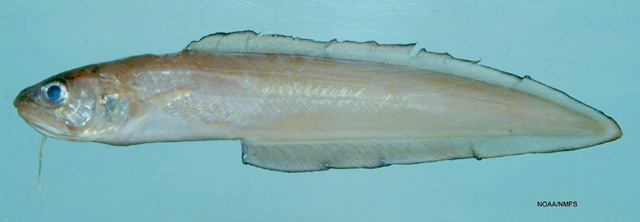| Ophidiidae (Cusk-eels), subfamily: Ophidiinae |
| 27.3 cm SL (male/unsexed) |
|
demersal; depth range 5 - 115 m |
| Western Atlantic: widespread along the Atlantic coast of the United States (from North Carolina), through the Gulf of Mexico and the Caribbean, to the coasts of South America (up to Uruguay); apparently absent in the Bahamas. |
|
Dorsal spines (total): 0-0; Dorsal soft rays (total): 120-134; Anal spines: 0-0; Anal soft rays: 99-110; Vertebrae: 69-74. Rostral spine long and curved, reaching tip of snout, without vertical basal component; peritoneum pale; no median basibranchial tooth patch; head extensively covered with imbricate rows of cycloid scales except for snout and throat; body tapering to point, dagger-shaped (Ref. 34024). Body dark gray or brownish gray without blotches; dorsal and anal fins dark, becoming gradually darker at the extreme blackish edge; pelvic fin blackish in anterior half and pale in posterior half; gill arch blackish or brownish; head covered with scales except for snout, lips, and branchiostegal membrane (Ref. 13608). |
| Common species (Ref. 34024). Found on soft bottom (Ref. 7251). Oviparous, with oval pelagic eggs floating in a gelatinous mass (Ref. 205). |
|
(Ref. 96402)
|
| harmless |
|
Source and more info: www.fishbase.org. For personal, classroom, and other internal use only. Not for publication.
Page created by Jen, 05.08.02,
php script by kbanasihan 06/09/2010 ,
last modified by
dsantos, 20/08/10

